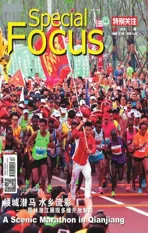The Tale of Crayfish-Rice Farming Mode—An Agricultural Revolution in Modern China
2018-05-15ByMaYalunWangBenlunZhangLing
By Ma Yalun, Wang Benlun & Zhang Ling

In central China’s Hubei Province extends a vast lowland region called Jianghan Plain. With the lowest elevation in the country, it occupies a fertile area of 46 thousand km². In the heart of it lies Qianjiang, a miraculous city covering an area of 2004 km². This city has been listed as one of the first National Modern Agricultural Industrial Parks and the only one in Hubei.
The reason why we label it“miraculous” is that it is abundant in grain yields (mainly wheat and rice), edible oil production(mainly from rapeseed and cotton), natural gas, and underground salt resources.People here are hardworking and good-natured and have been constantly creating historical achievements by turning this once easily waterlogged wasteland into a hometown of crayfish, a hub of crayfish-rice production,a wetlands town embedded in clusters of gardens, and a new site of petroleum production. Among these miracles, I would like to talk about the tale of crayfish-rice farming mode.
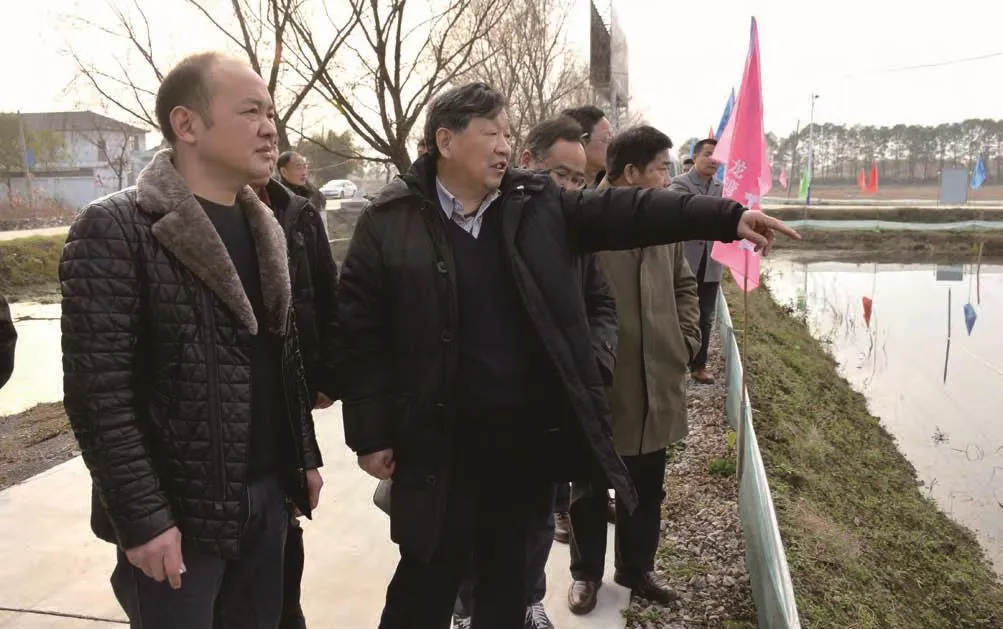
Academician Zhang Hongcheng (second from left) and Li Xiaoping, chief agronomist of the Agricultural Bureau of Qianjiang City ( first from left) investigating crayfish-rice fields张洪程院士(前左二)和潜江市总农业师李小平(前左一)考察虾稻田建设情况
The Crayfish-Rice Farming Mode is created by Qianjiang agricultural workers. Crayfish and rice—two unrelated species—have lived together so harmoniously in Qianjiang that it has triggered the attention of governments of each level. As the local crayfish is ending up on the dinner tables of every country, a new production mode has been fostered rapidly.This new technique is bound to become a widely-used form of biological agriculture and will certainly make tremendous contributions to the development of the agricultural industry and food safety in China.
“The mode is a typical example of Chinese modern agriculture,as well as a revolution,” said Mr.Wang Wu, a prestigious professor of Shanghai Ocean University and an expert of the Ministry of Agriculture.
Mo Dehai, the Pioneering Farmer
It was 3 pm, together with his family and the helpers, as per usual, Mo Dehai was laboring in his fields of crayfish and rice by Zhangjia Lake in Qianjiang. As we approached the field, Mo reached out his short and work-gnarled hands and shook ours. He was not so tall and had an upright and simple character. He was happy to hear us call him “Lao Mo.” (In Chinese culture, ‘lao,’ literally‘old,’ is a title of respect.)
“This is exactly our daily routine. The crayfishing goes from 2 am. And at 6 am, we send our catch to the market for sale.”
They had two meals a day and repeated this kind of work every day. Despite the hard work, Mo is always motivated. “We’ve got a lot of rice fields here, so we can only grow single-season rice.Farming in the traditional way could help us generate profits of only more than 600 yuan on one
mu (approx. 0.165 acre or 666.5 square meters) of land. However,the crayfish-rice field makes the net profit over 3000 yuan.” Saying this, Mo could not help eyes from twinkling with pleasure.
在中国中部的湖北省,绵延着中国海拔最低的江汉平原,面积4.6万平方公里;在这块富饶的平地中央,有一块2004平方公里的神奇土地,她就是全国首批、全省唯一的国家现代农业产业园所在地——潜江。说它神奇,是因为这里地上盛产粮(麦、稻为主)油(油菜)棉(棉花),地下富藏油(石油)气(天然气)盐(盐卤)。这里的人们勤劳朴实,不断创造着新的历史辉煌,从十年九涝的蛮荒之地,变成水乡园林、龙虾之乡、虾稻之乡。如今,创造发明仍在继续。我今天要讲的是这里的虾稻传奇。
虾(小龙虾)、稻是潜江所创“虾稻共作模式”的重要元素,这两种原本互不相干的生物,在潜江却联系得那么紧密,共生互补。在潜江龙虾风靡全球之际,这种新的生产方式正悄然兴起,它将成为健康农业的典型发展方式,必将为中国健康农业和国民舌尖上的安全做出巨大贡献。
这种模式受到国家高度重视和扶持,被农业部专家、上海海洋大学著名教授王武誉为中国现代农业的典型代表,是一次现代农业的革命。
莫德海试吃“螃蟹”
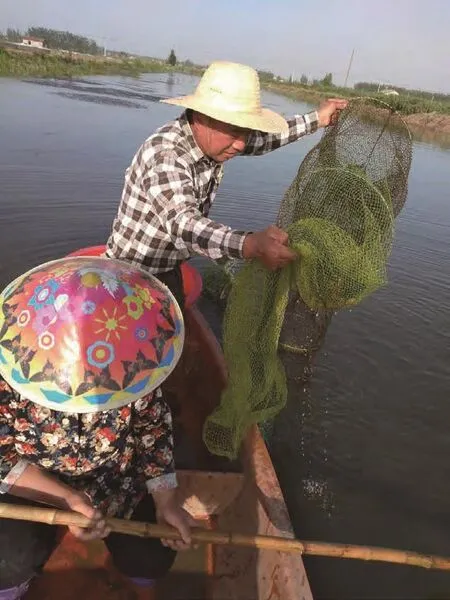
It’s time to fish for crayfish, Mo Dehai and his wife is taking out the crayfish caught in the tool called Dilong.眼下这片水域正值捕捞小龙虾的季节,莫德海和妻子取出地龙中捕获的小龙虾
时过午后3时,潜江市总口农场张家湖分场的莫德海跟平时一样,带着家人和请来帮忙的工人一起,在虾稻田里忙碌。我们来到田边,莫德海伸出短粗有力且布满厚厚老茧的双手,跟我们握手。他个子不高,憨厚耿直。我叫他老莫,他很高兴。
“我们每天都这样。凌晨2点下田捕捞,6点把捕获的虾子送到市场销售。虾运走后,我们才吃早饭,睡一会儿起来,回到田里给虾子投食。”事分两段,一日两顿,日复一日。老莫觉得事情很辛苦,但干得很带劲。“我们这里水田多,一年只能种一季水稻。以前传统方式耕作,一亩地忙下来,只能赚600多元。现在搞虾稻共作,纯利可达3000多元。”老莫禁不住的喜悦悄悄爬上眉梢。

Feeding crayfish with ground soybean把磨碎的黄豆投给虾子
他自豪地说,自己是张家湖第一个吃螃蟹的人。7年前,场长王乐成带着老莫等十几个农户到白鹭湖农场关山分场学习虾稻共作模式。回来后,老莫下决心搏一搏,放弃传统种植模式。他跟村民们商量租地时,大家都劝他放弃想法,但他还是坚定地与基地负责人刘军签下合作协议,并租下村民们手中的三百亩水田。
一年、两年、三年……村民们看着老莫的日子越来越好过,种养技术越来越成熟,纷纷把租给老莫的田收了回去,跟着老莫一起搞起虾稻共作来。老莫也不藏着掖着,把自己所知道的都告诉乡亲们,成了分场经验丰富的土技术员。亲戚们都到外地打工赚钱去了,老莫就把他们的地租过来打理,加起来150多亩。“我们几个人管这么多地,够了,多了也管不了。”我心里为老莫算了笔小账,这活累是累,但一年的收入买台奥迪A6却是绰绰有余。
村民刘国云说:“虾稻好吃,我们都喜欢吃,而且吃着放心。连我在武汉的侄子一家都要我们给他们寄虾稻。”刘国云说,比起传统的稻米,虾稻口感更好,酥润和胃。

A Russian guest tasting the rice俄罗斯客人品尝虾乡稻
Mo told us proudly that he was the first farmer to experiment with new patterns of farming.Seven years ago, Wang Lecheng,the head of the farm, led more than ten farmers, including Mo, to learn the Rice-Crayfish Farming Mode on Bailu Lake Farm.When Mo came back home, he was determined to experiment on the new farming pattern by abandoning the traditional one.Villagers were not supportive to his idea, but he insisted. He rented 300 mu rice land from them and entered a contract unhesitatingly with Liu Jun, the man in charge of the project.
After several years, seeing that Mo had improved his living conditions, villagers retrieved their rented fields from Mo and followed his path. Mo never hid anything and divulged all he knew to villagers as an experienced technician of his farm. When his relatives went out as migrant workers, he rented their fields,whose total acreage could surpass 150 mu. “There are just several of us who take care of all of these fields. It’s enough. We can’t afford anymore.” With some quick math in my head, I figured out that he could definitely afford an Audi A6 car with his annual income, even if the work was toilsome.
“Rice grown in the rice-crayfish farmland is tasty and nutritious.We all like it. Even my nephew’s family, who lives in Wuhan,asks us to send it to them,” said one villager named Liu Guoyun.According to her, this kind of rice tastes better and is better for the stomach, compared with that grown in traditional ways.
The Origin of the Ecologically Produced Rice
“The Rice-Crayfish Farming Mode is ecologically safe and natural,” confirmed Mr. Li Xiaoping, chief agronomist of the Agricultural Bureau of Qianjiang.The transformation of its fields is relatively simple: 20 to 40 mu of field constitutes a unit, along its perimeter is a ditch 2 to 4 m wide and 1 to 1.5 m deep, with water inlet or outlet at each end of the field. Inside the ditch and in the field are transplanted waterweeds such as Elodea nuttallii. The prevention of pests mainly relies on physical and biological methods, with little chemical prevention. After the harvest, the straws are returned to the field. As a result, less fertilizer is utilized.
The catch season begins in late March and ends in late June, when it is hot. The rise of the water temperature drives the crayfish to inhabit the deepwater areas of the ditch. It is at this moment that farmers drain away water slowly and transplant seedlings while dropping extra young crayfish. Then, around the paddies, farmers set up two layers of net. In every mu of field,farmers place 20 15-day-old ducklings, which leads to the coexistence of rice and duck.
生态稻米的起源
“虾稻是采用生态环保、近乎天然的生产方式种植出来的。”潜江市农业局总农艺师李小平说,虾稻田改造相对简单,按20亩至40亩一个单元,沿稻田开挖环形沟,沟宽3-4米,沟深1-1.5米,稻田两端分别安装进、排水口设施。在稻田和虾沟内移植伊乐藻等水草。虾稻病虫防治以物理防控、生物防控为主,化学防控为辅,收获后秸秆实行全量还田,肥料投入也相对减少。
每年3月下旬开始捕捞,至6月中下旬,气候炎热,水温升高,小龙虾转入沟内深水中生活,这时缓慢排水,整田插秧并补投虾苗,插秧完毕后,在秧田四周布上两层护网,按每亩20只的数量投放新孵出半月左右的小鸭,鸭稻共生。
“关于水稻,老百姓最关心的是舌尖上的安全,虾稻鸭天然解决病虫害。”湖北虾乡食品股份有限公司董事长刘军给我们讲述了天然的意义。“水稻虫害主要有三虫。螟虫、稻纵卷叶螟和稻飞虱,螟虫是本地残虫,在稻茬儿和杂草上越冬,后两种虫是迁徙性害虫,主要从南方迁入。”对于螟虫,一是利用太阳能频振灯诱杀,作为小龙虾的天然饵食;二是水稻收割后留下的秸杆与稻茬全部留在田里,通过水泡腐烂,可以泡死螟虫幼虫如蛹,没泡死的虫卵也与泡烂的稻茬一起被小龙虾吃掉。鸭子在秧株间穿梭觅食,稻纵卷叶螟和稻飞虱经常被鸭子扰动,无处藏身,或飞走或被鸭子吃掉,同时,鸭子穿梭间还会增加稻株通风透气和通光度,鸭粪则成为稻株生长的有机肥料。
“虾稻鸭种养模式,还有利于改善土壤性能。”潜江市国家现代农业办公室主任陈坤补充道。“这种改变体现在几个方面,一是虾稻鸭共生,大大减少了农药和化肥的使用量,虾肥鸭肥以及投喂食物都是水稻生长的天然肥料;二是虾子越冬,要往土壤深处打洞,有效改善耕作层深度,避免因土壤板结,有利水稻生长;三是为了达到消毒灭菌的目的,养殖户每年都要向虾田投放石灰。”
潜江市农业部门正联手重点虾稻企业,对虾稻的品质进行技术分析,确定各种虾稻的物理特性和各种技术参数,制定生产标准和检测标准,确保虾稻标准化生产。“When it comes to rice
production, food safety is a given priority for everyone. Ducks coexisting with rice plants and crayfish can reduce the risk of diseases and pests,” explained Mr. Liu Jun, president of Hubei Crayfish Land Food Co., Ltd.“Three pests, stem borers, rice worms, and rice plant hoppers,threaten the growth of rice. The former one is a local pest, living on the rice leaves and weeds and reeds; the latter two are migrating pests from the south.”Two methods are used for the killing stem borers. One is to kill them by trapping. By way of solar frequency vibrancy pest killing lamps, the pests naturally become the crayfish or ducks’food. The other method is to keep all the straws in the field. The rotten straws help decompose the remaining borers and worms in the water, and the crayfish swallow down the dying pest and the remaining rice stubbles.Furthermore, the ducks swim back and forth in the rice field and ventilate the plants so that the pests have to fly away or risk being eaten by ducks. Besides, the ducks’ movement brings more sunlight and air to the rice plants.Ducks’ droppings are also a source of organic fertilizer for the plants.

“The crayfish-rice farming pattern also improves the soil properties,” Mr. Chen Kun,director of National Modern Agricultural Bureau of Qianjiang,added. “Firstly, the co-existence means a largely reduced amount of pesticides and fertilizers;secondly, holes dug by crayfish for their hibernation can avoid soil hardening and benefit the growth of rice; thirdly, for the sake of disinfection and sterilization,farmers put lime in the field annually to ameliorate directly the acid/alkaline balance of soil.”
The Agricultural Department of Qianjiang is now in cooperation with relevant local key enterprises to conduct technical analysis on the rice quality, examine the physical characteristics of the rice, set up the technical parameters, and specify the production and check-up standards, so as to guarantee the standardized production of the crayfish rice.
Bright Future of Qianjiang’s Cray flsh-Rice Industry
Qianijang has been enjoying a high reputation as “the hometown of China’s crayfish,” “No.1 in exporting and processing crayfish in China,” and “the hometown of China’s crayfish rice.” Naturally,the crayfish-rice industry has become the pillar industry of the local agricultural economy.
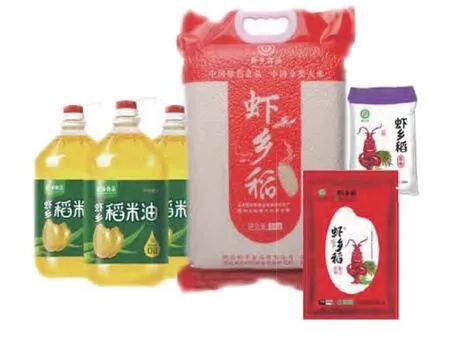
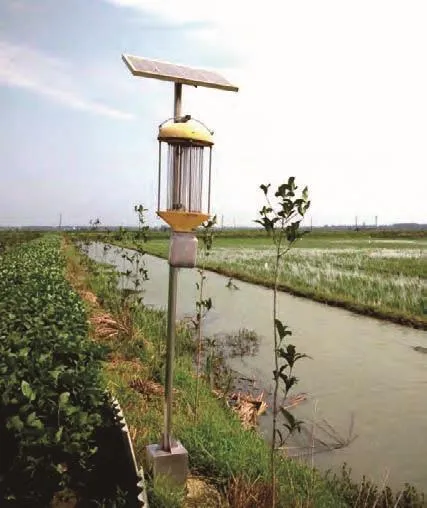
Solar frequency vibrancy pest killing lamp太阳能频振灯
In 2017, the value of the whole industry surpassed 23 billion yuan, thus becoming one of the first 11 “National Modern Agricultural Industrial Parks” and 62 “Predominant Areas of Local Agricultural Specialties,” the first in Hubei Province.
In 2010, the municipal government formed a team of innovators. After three years’diligence and devotion, the team succeeded in formulating and accomplishing the crayfish ecological farming pattern,which won the Hubei Provincial Innovation Award and produced approximately 200 kilograms of crayfish and 450 kilograms of rice per mu of field. The net return of each mu fluctuated around 5000 yuan.
In 2013, the municipal government became committed to promoting the crayfish-rice ecological farming pattern in Qianjiang by giving allowances(40 yuan/mu and 200 yuan/mu for poverty-stricken families)to farmers using this technique.In the years since 2014, newly developed bases were subsidized(40 yuan/mu). Currently, crayfishrice ecological farming fields have covered an area of 630 thousand mu.
Qian jiang, the only Demonstration City of Integrated Farming in China, has the ultimate say over national standardization in this field, since it has issued 14 standards related to the crayfish-rice cultivation,breeding, processing, and catering.Furthermore, a number of rice varieties produced through this new mode in Qianjiang have been listed as national green foods.
Qianjiang has also established an academic expert workstation in cooperation with Mr. Zhang Hongcheng, an agricultural expert,and worked closely with Hubei Academy of Agricultural Sciences on the screening and breeding of high-quality rice varieties.
At present, Qianjiang is striving to become a National Modern Agricultural Industrial Park,focusing on the establishment of a crayfish-rice farming base,four centers of big data, dealing,researching, and fine processing,as well as a financial aid platform for the crayfish-rice industry. The industrial park project involves a total investment of 1.753 billion yuan and subsidies from the central government amounting to 100 million yuan. ◆
(Translation: Zhu Jingtian)
潜江虾稻产业前景光明
潜江已成为“中国小龙虾之乡”、“中国小龙虾加工出口第一市”和“中国虾稻之乡”,虾稻产业已成为当地农业经济的特色支柱产业。2017年,潜江虾稻全产业链产值突破230亿元,成功入选全省唯一、全国首批11家“国家现代农业产业园”和62家“中国特色农产品优势区”创建单位。从2010年起,潜江市委、市政府成立了创新团队,历时3年,创新探索出“虾稻共作”生态种养模式,亩产小龙虾200公斤左右,产稻450公斤左右,亩平纯收入5000元左右,该项目荣获湖北省委改革奖。
2013年,市政府大力发展虾稻共作生态种养,对于新发展“虾稻共作”生态种养模式的养殖户,按照每亩40元的标准予以补贴,贫困户每亩补贴200元。2014年,又对新发展的千亩连片基地每亩给予40元的补贴。目前,全市“虾稻共作”面积达63万亩,建成13个万亩和60个千亩集中连片虾稻共作生态种养基地,预计可生产优质虾稻32万吨。
潜江是中国稻田综合种养示范市,在虾稻种养殖、繁育、加工、餐饮技术上共有14项标准,握有中国绝对话语权。虾乡稻、虾香稻、水乡虾稻等潜江虾稻大米荣获国家绿色食品及大米金奖。
潜江市已与张洪程水稻院士合作,成立了院士工作站,与省农科院紧密合作,开展虾稻高端优质稻品种筛选繁育。
眼下,潜江正着力创建国家现代农业产业园,重点建设一个虾稻共作现代农业生产基地,虾稻产业大数据中心、虾稻产业交易中心、虾稻产业研发中心、虾稻产品精深加工中心,一个虾稻产业金融扶农平台,总投资17.53亿元,中央奖补资金1亿元支持。◆


A corner of Qianjiang 园林水乡潜江一角
